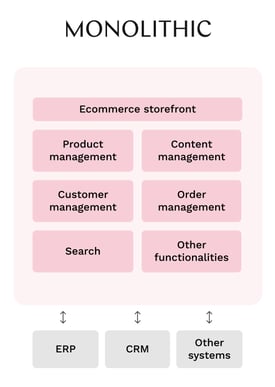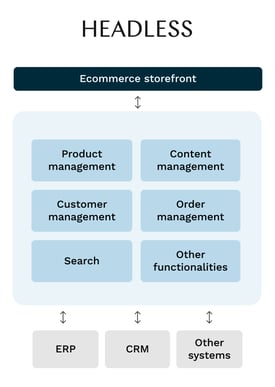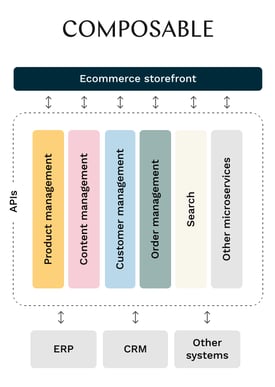Future-proof your ecommerce
Learn more about how we can help you with composable commerce
Explore composable commerceThe term composable commerce has been bubbling under in the ecommerce landscape lately. We believe it to be one of the most interesting developments in digital commerce for the upcoming years.
The microservices approach to IT architecture might be "nothing new" to some, but it has now become ever more relevant in digital sales. As there start to be numerous mature SaaS solutions for digital sales built API-first for a modular world, the time is right for composable commerce. Challenging the monolithic platform approach to ecommerce, composable commerce enables building business-critical, complex and scalable ecommerce flexibly and efficiently in the long run.
Despite its rising popularity, many still wonder what composable commerce is in essence and how it differs from other approaches to digital commerce. This blog post aims to bring clarity to these questions and lay the foundation on your understanding of composable commerce.
What is composable commerce?
Composable commerce refers to the IT architecture where your ecommerce is built using separate compatible pieces – according to your individual business needs. This modular approach allows companies to select the best microservices or packaged business capabilities for each functionality, creating a whole tailored to serve end customers best. Composable commerce evolves as your business evolves since new components can be added and one component can be switched to a better fit relatively easily.
Composing ecommerce this way allows companies to have more control over their IT architecture without being locked in one monolithic platform. This approach is made possible through MACH architecture, which stands for microservice-based, API-first, cloud-native SaaS, and headless.
Using separate microservices or packaged business capabilities for each functionality allows companies to adopt the "best-of-breed" approach, connecting the best available services through APIs. For instance, your search functionality can be provided by a search engine motor such as Algolia, whereas product information management is provided by, for example, Akeneo. The choice is yours.
One of composable commerce's greatest advantages is the flexibility it brings. Composable commerce is the go-to approach for companies looking to scale their business to new markets or expand their offering, as it's easy to plug in new services to the existing architecture. While orchestrating such architecture requires time and resources, in the long run taking the microservices approach can be more cost-effective. This is because new features can be made sure to not overlap with existing ones, and it can be more efficient to add functionalities, resulting in a lower total cost of ownership.
Composable commerce is also believed to bring significant improvements to the speed at which companies can scale their business. Gartner's report boldly states that by 2023, organisations that have adopted a composable commerce approach will outpace the competition by 80% in the speed of new feature implementation. While we are hesitant to claim any technology to be a one-size-fits-all solution to every business problem, composable commerce can undoubtedly bring certain companies clear advantages and help take digital sales to the next level.
Finding the right fit: Monolithic, headless or composable commerce
Digital sales trends tend to come in cycles. Sometimes it's recommended to have a separate tool for each need, while other times, big platforms make grand promises of taking care of everything under one roof. Figuring out the right approach, monolithic, headless or composable, begins with understanding the benefits and challenges of each.



In theory, having one monolithic platform to cover everything in your ecommerce, is exceptionally promising from the ease-of-use point-of-view. Platforms such as Adobe Commerce or Shopify are equipped to handle everything from content management to search, pricing, product data and everything in between. If your ecommerce is easily confined, having monolithic architecture should make sense. For instance, for a small direct-to-customer company with a simple product portfolio, platforms make it easy to expand the business from brick-and-mortar to online.
Sometimes, however, your ecommerce benefits from having a more flexible architecture. Monolithic platforms can be found challenging to modify to specific needs. You might be stuck with a front-end template from years ago that you find difficult to update to support the use cases of today. Not only that, but monoliths can also be inflexible in terms of the development process, as changes to one part of the system may require changes to other parts of the system. This can slow down the development process, and even the most minor changes can take an unreasonable amount of time. As your business grows, you need to invest constantly in upgrades in the platform. Soon you might find yourself stuck with a platform that doesn't enable you to grow and evolve your business as you should be able to.
To increase flexibility and scalability, many opt for headless or composable commerce instead of monoliths. Headless commerce has been talked about for some time. In essence, it means separating the front end from the back end, allowing for increased flexibility in terms of customer experience. This can be beneficial for, for example, companies looking to build separate B2C and B2B web shops using the same back-end.
Composable commerce takes this a few steps further by separating each functionality from the other. The approach is the recommended route for companies building complex and business-critical ecommerce, with an ambitious omnichannel strategy.
Promising more flexibility, efficacy and scalability, composable commerce might be the best approach for future ecommerce in many cases. Yet, as stated before, it's not a one-size-fits-all solution and often monolithic architecture works sufficiently well. In our series of blog posts about composable commerce, we will next help you identify when composable commerce is relevant to your business. Ultimately, finding the right fit is about understanding what technical solutions enable you to reach your business objectives best.
The composable commerce guide
What is composable commerce, who is it relevant to and what platforms enable the approach? Discover composable commerce with this guide.
Download




